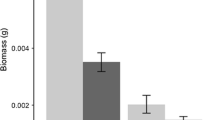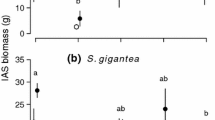Abstract
Exotic species are often predicted to successfully invade when their functional traits differ from species in recipient communities. Many studies have related trait differences among natives and invaders to competitive outcomes. Few studies, however, have tested whether functionally similar invaders have similar competitive impacts on natives. We investigated interactions in communities of a native annual forb Waitzia acuminata (Asteraceae) and two invasive annual grasses that are ecologically similar and co-occur in southwestern Australia. Using a combination of field and laboratory experiments and several performance measures, we assessed impacts of these grasses on W. acuminata. We also examined differences among species in their responses to intraspecific versus interspecific competition, including their frequency dependence. The two similar exotic grasses differed in interaction impacts, with one facilitating and the other suppressing the native. In general, intraspecific competition was stronger than interspecific competition for the native, while evidence of competition was weak for the exotics. These patterns may reflect that W. acuminata does well in these communities due to the combined impacts of stabilization and facilitation, whereas the exotics benefit from limited stabilization (mediated by their weak intraspecific competition) or weak interspecific competition with W. acuminata. We found divergent impacts of the exotic species despite their similar functional traits. We demonstrate that a native species may benefit from interactions with an exotic “benefactor” species, highlighting the potential importance of positive interactions in invaded communities. Our findings underscore the necessity of considering neutral and positive interactions in addition to competition in understanding invasion dynamics in real plant communities.




Similar content being viewed by others
Data availability
The data sets generated and/or analysed during the current study are available in the figshare repository, https://doi.org/10.6084/m9.figshare.8316515.
References
Adler PB, HilleRisLambers J, Levine JM (2007) A niche for neutrality. Ecol Lett 10:95–104. https://doi.org/10.1111/j.1461-0248.2006.00996.x
AVH (2019) Australia’s Virtual Herbarium, Council of Heads of Australasian Herbaria. https://avh.chah.org.au/. Accessed 11 July 2019
Bates D, Maechler M, Bolker B, Walker S (2015) Fitting linear mixed-effects models using lme4. J Stat Softw 67:1–48. https://doi.org/10.18637/jss.v067.i01
Batten KM, Scow KM, Espeland EK (2008) Soil microbial community associated with an invasive grass differentially impacts native plant performance. Microb Ecol 55:220–228. https://doi.org/10.1007/s00248-007-9269-3
Beard JS (1998) Position and developmental history of the central watershed of the Western Shield, Western Australia. J R Soc West Aust 81:157–164
Burvill (1979) The first sixty years, 1829–1869. University of Western Australia, Nedlands
Callaway RM (2007) Positive interactions and interdependence in plant communities. Springer, Amsterdam
Chesson P (2000) Mechanisms of maintenance of species diversity. Annu Rev Ecol Syst 31:343–366. https://doi.org/10.1146/annurev.ecolsys.31.1.343
Daehler CC (2003) Performance comparisons of co-occurring native and alien invasive plants: implications for conservation and restoration. Annu Rev Ecol Evol Syst 34:183–211. https://doi.org/10.1146/annurev.ecolsys.34.011802.132403
Davis MA, Chew MK, Hobbs RJ, Lugo AE, Ewel JJ, Vermeij GJ, Brown JH, Rosenzweig ML, Gardener MR, Carroll SP (2011) Don't judge species on their origins. Nature 474:153–154. https://doi.org/10.1038/474153a
Drenovsky RE, Grewell BJ, D'Antonio CM, Funk JL, James JJ, Molinari N, Parker IM, Richards CL (2012) A functional trait perspective on plant invasion. Ann Bot 110:141–153. https://doi.org/10.1093/aob/mcs100
Dwyer JM, Hobbs RJ, Mayfield MM (2014) Specific leaf area responses to environmental gradients through space and time. Ecology 95:399–410. https://doi.org/10.1890/13-0412.1
Dwyer JM, Hobbs RJ, Wainwright CE, Mayfield MM (2015) Climate moderates release from nutrient limitation in natural annual plant communities. Glob Ecol Biogeogr 24:549–561. https://doi.org/10.1111/geb.12277
Elgar AT, Freebody K, Pohlman CL, Shoo LP, Catterall CP (2014) Overcoming barriers to seedling regeneration during forest restoration on tropical pasture land and the potential value of woody weeds. Front Plant Sci 5:200. https://doi.org/10.3389/fpls.2014.00200
Elston D, Moss R, Boulinier T, Arrowsmith C, Lambin X (2001) Analysis of aggregation, a worked example: numbers of ticks on red grouse chicks. Parasitology 122:563–569. https://doi.org/10.1017/S0031182001007740
Elton CS (1958) The ecology of invasions by plants and animals. Methuen, London, p 18
Facelli JM, Pickett ST (1991) Plant litter: its dynamics and effects on plant community structure. Bot Rev 57:1–32. https://doi.org/10.1007/BF02858763
Flory SL, Clay K (2010) Non-native grass invasion alters native plant composition in experimental communities. Biol Invasions 12:1285–1294. https://doi.org/10.1007/s10530-009-9546-9
Fridley JD, Stachowicz JJ, Naeem S, Sax DF, Seabloom EW, Smith MD, Stohlgren TJ, Tilman D, Holle BV (2007) The invasion paradox: reconciling pattern and process in species invasions. Ecology 88:3–17. https://doi.org/10.1890/0012-9658(2007)88[3:TIPRPA]2.0.CO;2
Funk JL, Vitousek PM (2007) Resource-use efficiency and plant invasion in low-resource systems. Nature 446:1079–1081. https://doi.org/10.1038/nature05719
Gilbert B, Levine JM (2013) Plant invasions and extinction debts. Proc Natl Acad Sci 110:1744–1749. https://doi.org/10.1073/pnas.1212375110
Hothorn T, Bretz F, Westfall P (2008) Simultaneous inference in general parametric models. Biom J 50:346–363
Hoyle GL, Daws MI, Steadman KJ, Adkins SW (2008) Pre-and post-harvest influences on physiological dormancy alleviation of an Australian Asteraceae species: Actinobole uliginosum (A. Gray) H. Eichler. Seed Sci Res 18:191–199. https://doi.org/10.1017/S0960258508082986
Jordan NR, Larson DL, Huerd SC (2008) Soil modification by invasive plants: effects on native and invasive species of mixed-grass prairies. Biol Invasions 10:177–190. https://doi.org/10.1007/s10530-007-9121-1
Kanowski J, Catterall CP, Neilan W (2008) Potential value of weedy regrowth for rainforest restoration. Ecol Manag Restor 9:88–99. https://doi.org/10.1111/j.1442-8903.2008.00399.x
Knight K, Kurylo J, Endress A, Stewart JR, Reich P (2007) Ecology and ecosystem impacts of common buckthorn (Rhamnus cathartica): a review. Biol Invasions 9:925–937. https://doi.org/10.1007/s10530-007-9091-3
Kueffer C, Schumacher E, Fleischmann K, Edwards PJ, Dietz H (2007) Strong below-ground competition shapes tree regeneration in invasive Cinnamomum verum forests. J Ecol 95:273–282. https://doi.org/10.1111/j.1365-2745.2007.01213.x
Lai HR, Mayfield MM, Gay-des-combes JM, Spiegelberger T, Dwyer JM (2015) Distinct invasion strategies operating within a natural annual plant system. Ecol Lett 18:336–346. https://doi.org/10.1111/ele.12414
Leishman MR, Thomson VP, Cooke J (2010) Native and exotic invasive plants have fundamentally similar carbon capture strategies. J Ecol 98:28–42. https://doi.org/10.1111/j.1365-2745.2009.01608.x
Lenz TI, Facelli JM (2003) Shade facilitates an invasive stem succulent in a chenopod Shrubland in South Australia. Austral Ecol 28:480–490. https://doi.org/10.1046/j.1442-9993.2003.01304.x
Lloret F, Médail F, Brundu G, Camarda I, Moragues E, Rita J, Lambdon P, Hulme PE (2005) Species attributes and invasion success by alien plants on Mediterranean islands. J Ecol 93:512–520. https://doi.org/10.1111/j.1365-2745.2005.00979.x
Mayfield MM, Stouffer DB (2017) Higher-order interactions capture unexplained complexity in diverse communities. Nat Ecol Evol 1:0062. https://doi.org/10.1038/s41559-016-0062
Miki T, Ushio M, Fukui S, Kondoh M (2010) Functional diversity of microbial decomposers facilitates plant coexistence in a plant–microbe–soil feedback model. Proc Natl Acad Sci 107:14251–14256. https://doi.org/10.1073/pnas.0914281107
Pec GJ, Carlton GC (2014) Positive effects of non-native grasses on the growth of a native annual in a Southern California Ecosystem. PLoS ONE 9:e112437. https://doi.org/10.1371/journal.pone.0112437
Pinheiro J, Bates D, DebRoy S, Sarkar D, R Core Team. (2014) nlme: Linear and Nonlinear Mixed Effects Models. R package version 3.1-118
Prober SM, Wiehl G (2011) Resource heterogeneity and persistence of exotic annuals in long-ungrazed Mediterranean-climate woodlands. Biol Invasions 13:2009–2022. https://doi.org/10.1007/s10530-011-0017-8
Quevedo-Robledo L, Pucheta E, Ribas-Fernández Y (2010) Influences of interyear rainfall variability and microhabitat on the germinable seed bank of annual plants in a sandy Monte Desert. J Arid Environ 74:167–172. https://doi.org/10.1016/j.jaridenv.2009.08.002
R Core Team (2014) R: a language and environment for statistical computing. R Foundation for Statistical Computing, Vienna, Austria
Richardson DM, Pyšek P (2008) Fifty years of invasion ecology–the legacy of Charles Elton. Divers Distrib 14:161–168
Rodriguez LF (2006) Can invasive species facilitate native species? Evidence of how, when, and why these impacts occur. Biol Invasions 8:927–939. https://doi.org/10.1007/s10530-005-5103-3
Sax DF, Gaines SD (2008) Species invasions and extinction: the future of native biodiversity on islands. Proc Natl Acad Sci 105:11490–11497. https://doi.org/10.1073/pnas.0802290105
Schlaepfer MA, Sax DF, Olden JD (2011) The potential conservation value of non-native species. Conserv Biol 25:428–437
Seabloom EW, Harpole WS, Reichman O, Tilman D (2003) Invasion, competitive dominance, and resource use by exotic and native California grassland species. Proc Natl Acad Sci 100:13384–13389. https://doi.org/10.1073/pnas.1835728100
Seabloom EW, Borer ET, Buckley Y, Cleland EE, Davies K, Firn J, Harpole WS, Hautier Y, Lind E, Macdougall A (2013) Predicting invasion in grassland ecosystems: is exotic dominance the real embarrassment of richness? Glob Change Biol 19:3677–3687. https://doi.org/10.1111/gcb.12370
Simberloff D, Von Holle B (1999) Positive interactions of nonindigenous species: invasional meltdown? Biol Invasions 1:21–32. https://doi.org/10.1023/A:1010086329619
Titus JH, Tsuyuzaki S (2002) Influence of a non-native invasive tree on primary succession at Mt. Koma, Hokkaido Japan. Plant Ecol 169:307–315. https://doi.org/10.1023/A:1026081910749
Van Kleunen M, Weber E, Fischer M (2010) A meta-analysis of trait differences between invasive and non-invasive plant species. Ecol Lett 13:235–245. https://doi.org/10.1111/j.1461-0248.2009.01418.x
Vilà M, Espinar JL, Hejda M, Hulme PE, Jarošík V, Maron RL, Pergl J, Schaffer U, Sun Y, Pyšek P (2011) Ecological impacts of invasive alien plants: a meta-analysis of their effects on species, communities, and ecosystems. Ecol Lett 14:702–708. https://doi.org/10.1111/j.1461-0248.2011.01628.x
Wainwright CE, Dwyer JM, Hobbs RJ, Mayfield MM (2017a) Diverse outcomes of species interactions in an invaded annual plant community. J Plant Ecol 10:918–926. https://doi.org/10.1093/jpe/rtw102
Wainwright CE, Dwyer JM, Mayfield MM (2017b) Effects of exotic annual grass litter and local environmental gradients on annual plant community structure. Biol Invasions 19:479–491. https://doi.org/10.1007/s10530-016-1303-2
Wolfe BE, Klironomos JN (2005) Breaking new ground: soil communities and exotic plant invasion. Bioscience 55:477–487. https://doi.org/10.1641/0006-3568(2005)055[0477:BNGSCA]2.0.CO;2
Wolkovich EM, Cleland EE (2010) The phenology of plant invasions: a community ecology perspective. Front Ecol Environ 9:287–294. https://doi.org/10.1890/100033
Acknowledgements
Richard J. Hobbs, John M. Dwyer, and Myron Zalucki provided advice on experimental design, data analysis, and editorial input on earlier versions of this manuscript. Hao Ran Lai, Janneke HilleRisLambers, Xingwen Loy, Angela Gardner, Lalita Fitrianti, and the Schmidt Lab provided assistance with data collection. This research was funded by a grant from the Australian Research Council (DP1094413) awarded to Richard J. Hobbs, Margaret M. Mayfield, and Robert D. Holt. The Western Australian Department of Parks and Wildlife generously provided access to research sites.
Author information
Authors and Affiliations
Contributions
All authors conceived the ideas underlying the study. The experiments were designed primarily by CW and MM with input from RH. CW collected the data with input from RH and analysed the data with input from MM. CW wrote the manuscript with substantial input from RH and MM.
Corresponding author
Ethics declarations
Conflict of interest
The authors declare that they have no conflict of interest.
Additional information
Communicated by Jonathan A. Myers.
Electronic supplementary material
Below is the link to the electronic supplementary material.
Rights and permissions
About this article
Cite this article
Wainwright, C.E., Holt, R.D. & Mayfield, M.M. Looks can be deceiving: ecologically similar exotics have different impacts on a native competitor. Oecologia 190, 927–940 (2019). https://doi.org/10.1007/s00442-019-04468-z
Received:
Accepted:
Published:
Issue Date:
DOI: https://doi.org/10.1007/s00442-019-04468-z




